Issue Aiko, Princess Toshi Name Masako, Princess Father Hisashi Owada House Imperial House of Japan | Mother Yumiko Egashira Children Aiko, Princess Toshi Religion Shinto | |
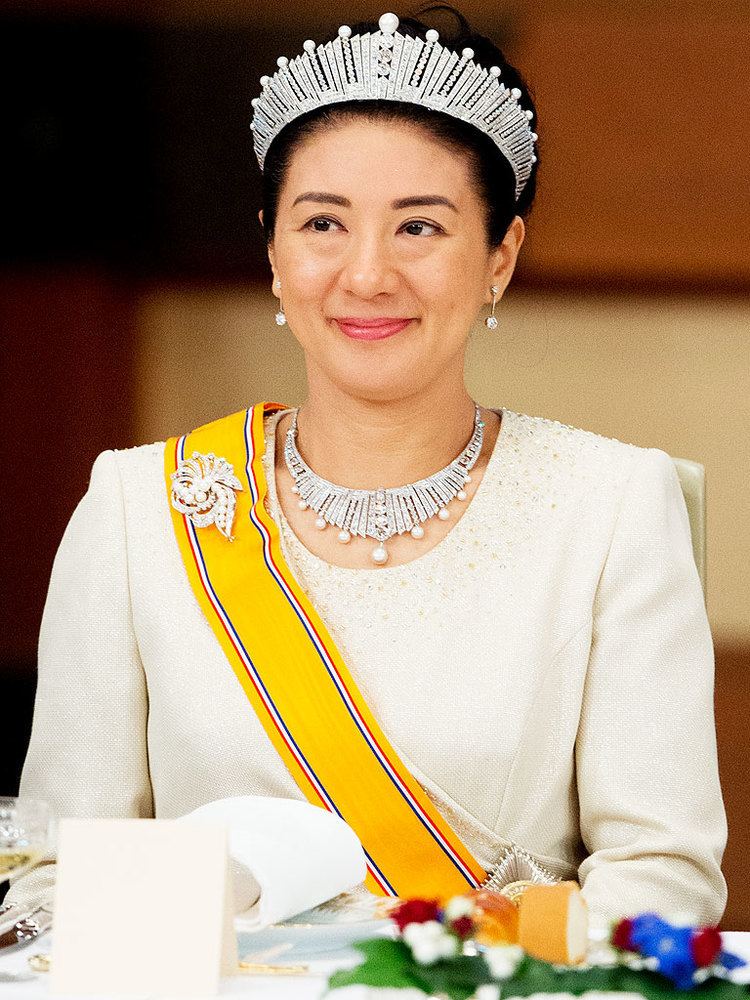 | ||
Born 9 December 1963 (age 61)
Toranomon Hospital, Tokyo, Japan ( 1963-12-09 ) Spouse Naruhito, Crown Prince of Japan (m. 1993) Parents Yumiko Egashira, Hisashi Owada Education University of Oxford, University of Tokyo, Belmont High School, Radcliffe College, Harvard College, Harvard University Similar People Naruhito - Crown Prince of, Aiko - Princess Toshi, Empress Michiko, Hisashi Owada, Kiko - Princess Akishino | ||
Masako crown princess of japan
Masako, Crown Princess of Japan (皇太子徳仁親王妃雅子, Kōtaishi Naruhito Shinnōhi Masako), born Masako Owada (小和田雅子, Owada Masako) on 9 December 1963, is the wife of Naruhito, Crown Prince of Japan, who is the eldest son of Emperor Akihito and Empress Michiko and the heir apparent to the Chrysanthemum Throne. She is a member of the Imperial House of Japan through marriage. Should the Crown Prince ascend the throne as expected upon his father's abdication, Masako will become empress consort.
Contents
- Masako crown princess of japan
- Early life and education
- Employment
- Courtship and marriage
- Children
- Succession
- Official duties
- Health
- Titles and styles
- National honours
- Foreign honours
- Honorary positions
- Ancestry
- References

Early life and education
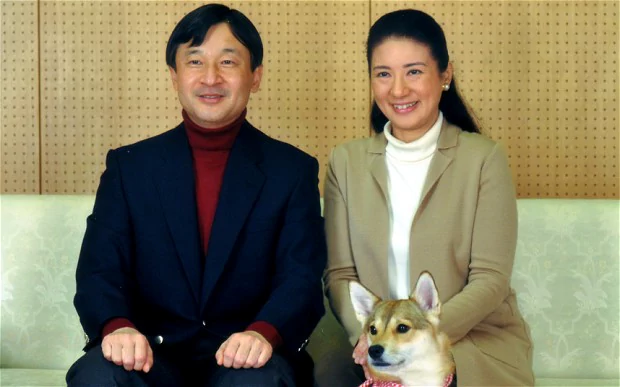
Masako Owada (小和田雅子, Owada Masako) was born in Tokyo, on 9 December 1963, at Toranomon Hospital in Toranomon. Masako is the eldest daughter of Yumiko Egashira and Hisashi Owada, a senior diplomat and former president of the International Court of Justice. She has two younger sisters, twins named Setsuko and Reiko.
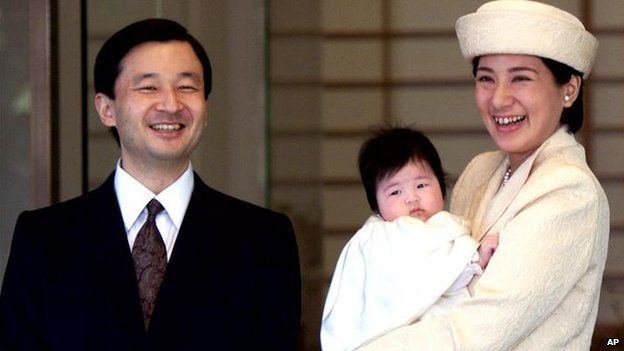
Masako went to live in Moscow with her parents when she was two years old, where she attended Detskiysad (kindergarten in Russian) No. 1127 daycare. At the age of five, Masako's family moved to New York City, where she attended New York City public kindergarten No. 81.
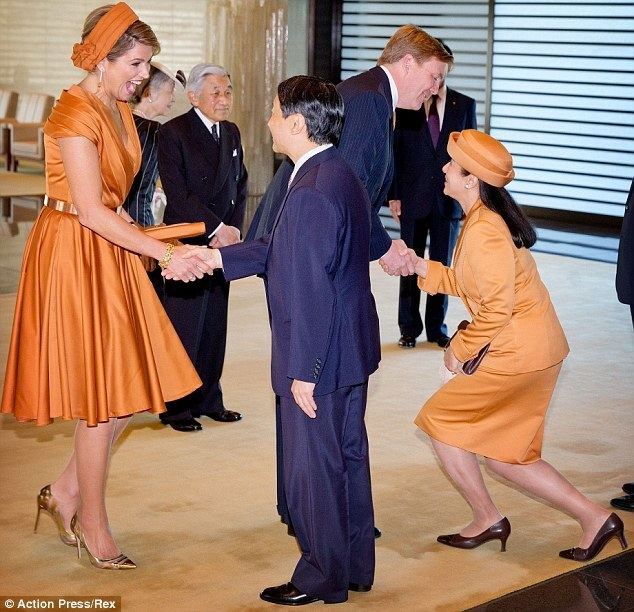
In 1971, the Owadas returned to Japan, moving in with her maternal grandparents in Meguro while Hisashi returned to the Foreign Ministry office. After failing the entrance examination and attending two other schools in a span of a few weeks, Masako was able to enter Futaba Gakuen, a private Roman Catholic girls' school in Denenchofu, Tokyo. Established by the Congregation of the Holy Infant Jesus in 1872, Masako's mother and maternal grandmother had graduated from this school as well. It was here that Masako learned to play piano and tennis, joined a handicrafts club, and became interested in animals, tending several after school and deciding to become a veterinarian. Masako also studied her fourth and fifth languages, French and German. With a school friend, Masako revived Futaba's softball team, serving as third baseman and after three years bringing her team to the district championships.
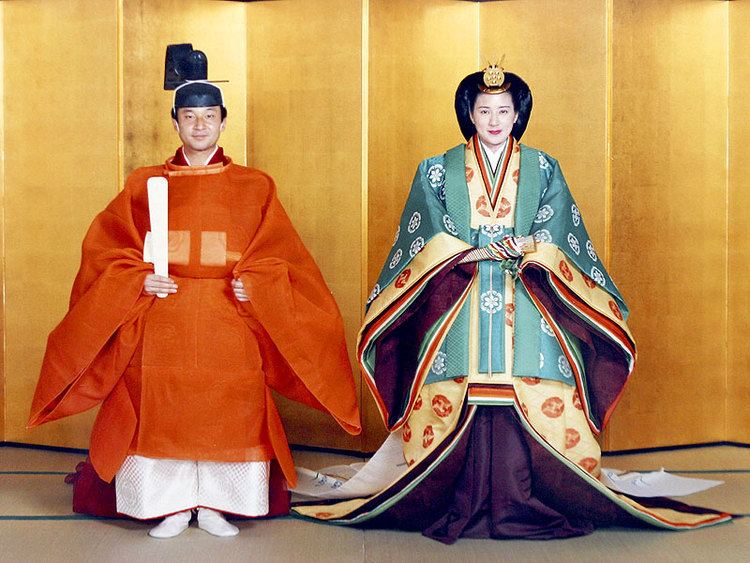
In 1979, her second year of senior high school, Masako and her family moved to the United States and settled in the Boston suburb of Belmont, Massachusetts, where her father became a guest professor of international law at Harvard College's Centre for International Affairs. In 1981, she graduated from the co-educational Belmont High School, where she was president of the National Honor Society and participated in the school's math team and French club. Masako joined the school's softball team and won a Goethe Society award for her German poetry. Masako even participated in a production of M*A*S*H.
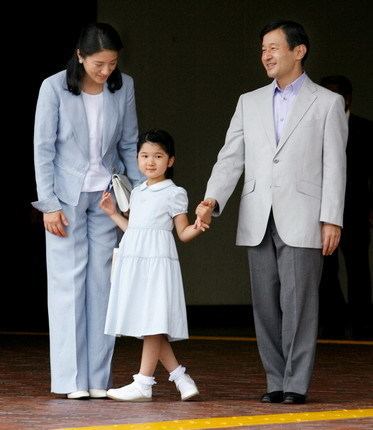
Masako enrolled in the Economics Department of Harvard University/Radcliffe College in 1981. When her father received a posting in Moscow after her graduation, it was decided that Masako would stay in Boston to attend school under the guardianship of her father's Harvard friends Oliver and Barbara Oldman. At Harvard-Radcliffe Masako became chairman of the school's Japan Society, "became quite close friends with the then Japanese consul in Boston, and volunteered as a kind of self-appointed diplomat and cultural ambassador" in the wake of mounting Japan–United States trade tension. Masako liked to ski and traveled overseas during vacations, staying with a host family in France and studying at the Goethe-Institut. Masako worked with Jeffrey Sachs to obtain a A.B. magna cum laude in economics in March 1985.
Employment
After graduation Masako moved back to Japan, where for six months (April to October 1986) she studied law at the University of Tokyo to prepare for the Japanese Ministry of Foreign Affairs's entrance examination. Out of 800 applicants only 28 passed, three of them being Masako and two other women.
"She was assigned, first, to the oddly named Second International Organizations Division which deals with Japan's relations with international agencies, such as the OECD, a club of 30 rich countries committed to free trade and development. Her assignments included dealing with the OECD's environmental affairs committee ... by all accounts she acquitted herself well—her command of spoken languages, so rare in Japan, was a huge advantage—and was popular with most of her workmates." During her free time, Masako attended cooking classes to, according to interviews with her instructor, "be able to cook proper Japanese dishes when she was entertaining [foreigners]."
Two years later, in 1988, Masako was chosen by the Ministry to be sponsored for two years' postgraduate study overseas with full pay, just as her father Hisashi had been years earlier. Masako "desperately wanted to go back to Harvard to do her masters". According to her former Harvard adviser Oliver Oldman, she "tried to re-enroll to work towards ... a Juris Doctor. However, Harvard's bureaucrats would not give her credit for her study-time at the University of Tokyo." Therefore, Masako enrolled in her second choice, studying International Relations under Sir Adam Roberts at Balliol College, Oxford. However, for unclear reasons Masako did not finish her thesis and instead returned to Japan in 1990.
Courtship and marriage
Masako first met Naruhito, Crown Prince of Japan, at a tea for Infanta Elena, Duchess of Lugo in November 1986, during her studies at the University of Tokyo. The prince was immediately captivated by her and arranged for them to meet several times over the next few weeks. Because of this they were pursued relentlessly by the press throughout 1987. However, Masako's name disappeared from the list of possible royal brides due to controversy about her maternal grandfather, Yutaka Egashira, who while working for the Industrial Bank of Japan was assigned to take over management of one of its creditors the Chisso Corporation to prevent it from financial collapse. Chisso, built in the 1930s, dumped the methylmercury used to make acetaldehyde (a chemical in plastic) into the water surrounding Minamata and other towns, causing the infamous Minamata disease and the resulting scandal.
Despite this controversy and Masako's travelling to Oxford University's Balliol College for the next two years, Naruhito remained interested in her.
Masako refused to marry the prince because it would force her to give up her promising career in diplomacy and severely restrict her independence and freedoms. Masako finally accepted his third proposal on 9 December 1992. It was reported that he argued that serving as Crown Princess of Japan would only be "another form of diplomacy" before she finally accepted this third proposal. The Imperial Household Council formally announced the engagement on 19 January 1993; the engagement ceremony was held on 12 April 1993. Although many were surprised at the news, as it was believed that the prince and Masako had separated, the engagement was met with a surge of renewed media attention directed toward the Imperial family and their new princess.
Masako married Crown Prince Naruhito in a traditional wedding ceremony on 9 June 1993. By virtue of the marriage, Masako Owada assumed the formal style Her Imperial Highness The Crown Princess of Japan. As tradition dictates, upon her entry into the imperial family and like other members, she received a personal emblem (o-shirushi (お印)): rosa rugosa (hamanasu (ハマナス)). In addition, she was placed in the Japanese Imperial Order of Precedence (used for the most formal occasions) behind her mother-in-law, Empress Michiko, and her grandmother-in-law, Empress Dowager Nagako.
The Crown Prince and Crown Princess marked their 20th wedding anniversary in June 2013.
Children
The Crown Princess' first pregnancy was announced in December 1999, but she miscarried.
The Crown Prince and Crown Princess have one daughter: Aiko, Princess Toshi (敬宮愛子内親王, Toshi-no-miya Aiko Naishinnō, born 1 December 2001).
Succession
Their daughter's birth, which occurred more than eight years after their marriage, sparked lively debate in Japan about whether The Imperial Household Law of 1947 should be changed from that of agnatic primogeniture to either cognatic or absolute primogeniture, which would allow a woman to succeed to the Chrysanthemum Throne.
A government-appointed panel of experts submitted a report on 25 October 2005, recommending that the Imperial Succession Law be amended to permit absolute primogeniture. On 20 January 2006, Prime Minister Junichiro Koizumi used part of his annual keynote speech to address the controversy when he pledged to submit a bill to the Diet letting women ascend to the throne in order that the imperial throne be continued in a stable manner. Koizumi did not announce a timing for the legislation to be introduced nor did he provide details about the content, but he did note that it would be in line with the conclusions of the 2005 Government Panel.
Plans to change the male-only law of Imperial succession were shelved after it was announced in February 2006 that Masako's brother-in-law and his wife, Prince and Princess Akishino, were expecting their third child. On 6 September 2006, Princess Akishino gave birth to a son, Hisahito, who is third-in-line to the Chrysanthemum Throne under the current law, after his uncle, the Crown Prince, and his father, Prince Akishino.
Official duties
Saudi Arabia, Oman, Qatar and Bahrain were the countries visited by the couple in 1994. They visited Kuwait, the United Arab Emirates and Jordan in 1995, and again traveled to Jordan in 1999. In 1999, they also went to Belgium to attend the wedding of Prince Philippe, Duke of Brabant. In 2002, they paid a visit to New Zealand and Australia. In 2006, the Crown Prince and Crown Princess went to the Netherlands with their daughter, Princess Aiko, at the invitation of Queen Beatrix of the Netherlands for a private visit.
On 30 April 2013, the Crown Prince and Crown Princess were present at the inauguration of King Willem-Alexander of the Netherlands, which was the Crown Princess's first official overseas appearance in eleven years. In October 2014, she was present at a banquet held in honour of King Willem-Alexander and Queen Máxima at the Tokyo Imperial Palace, which was her first appearance in such a ceremony in eleven years. She welcomed the couple during an official ceremony at the palace which was her first appearance in a welcoming ceremony after five years. In July 2015, Princess Masako traveled to Tonga with the Crown Prince in order to attend the Coronation of King Tupou VI. Over 40 members of the Japanese media covered the event, during which the happy-looking Crown Princess was warmly welcomed. In November 2015, the Crown Princess attended the Autumn Imperial Garden Party at Akasaka Imperial Garden. It was the first time for her to attend the event in twelve years.
Health
Princess Masako has remained largely out of the public eye since 2002, reportedly due to emotional disorders which many speculate are caused by the pressure to produce a male heir and adjusting to life in the Imperial Family. In July 2004, she was diagnosed as suffering from adjustment disorder and was reported to be seeking treatment.
On 11 July 2008, Naruhito sought public understanding for his ailing wife. He was on an eight-day trip to Spain without her: "I would like the public to understand that Masako is continuing to make her utmost efforts with the help of those around her. Please continue to watch over her kindly and over the long term." Pressures to produce a male heir, to conform with the ancient traditions and a 1947 Imperial Household Law are perceived to be behind her illness, as well as negative media coverage of her behavior, the stress of royal responsibility and public life, and turf battles among the Imperial Household Agency.
In December 2012, at the time of her 49th birthday, the Princess issued a statement thanking the Japanese people for their support and saying that she was still receiving treatment for her illness.
The Japanese Constitution does not allow the members of the Imperial Family to engage in political activities. The Prince made controversial comments about discourtesies and pressures placed on his wife by the Imperial Household Agency and his wife's desire to pursue the life of a diplomat.
Titles and styles
National honours
Foreign honours
Honorary positions
Ancestry
Her father Hisashi is descended from the Owada clan, whose head Shinroku—Masako's 4th-great grandfather—was called to Murakami in 1787 to serve the Naito clan that the Tokugawa shogun had installed as the city's rulers 67 years earlier. After the fall of the shogunate, the Owadas participated in a salmon-fishing cooperative, the proceeds of which provided schooling for many local children, including Hisashi and his father Takeo.
Her mother Yumiko is descended from the Egashira clan which served the Saga clans near Nagasaki on the island of Kyushu. One of the Egashiras, Yasutaro, went on to command a battleship in the Russo-Japanese War. Yumiko's father was a wealthy banker who was at the time of her marriage the managing director of the Industrial Bank of Japan.
